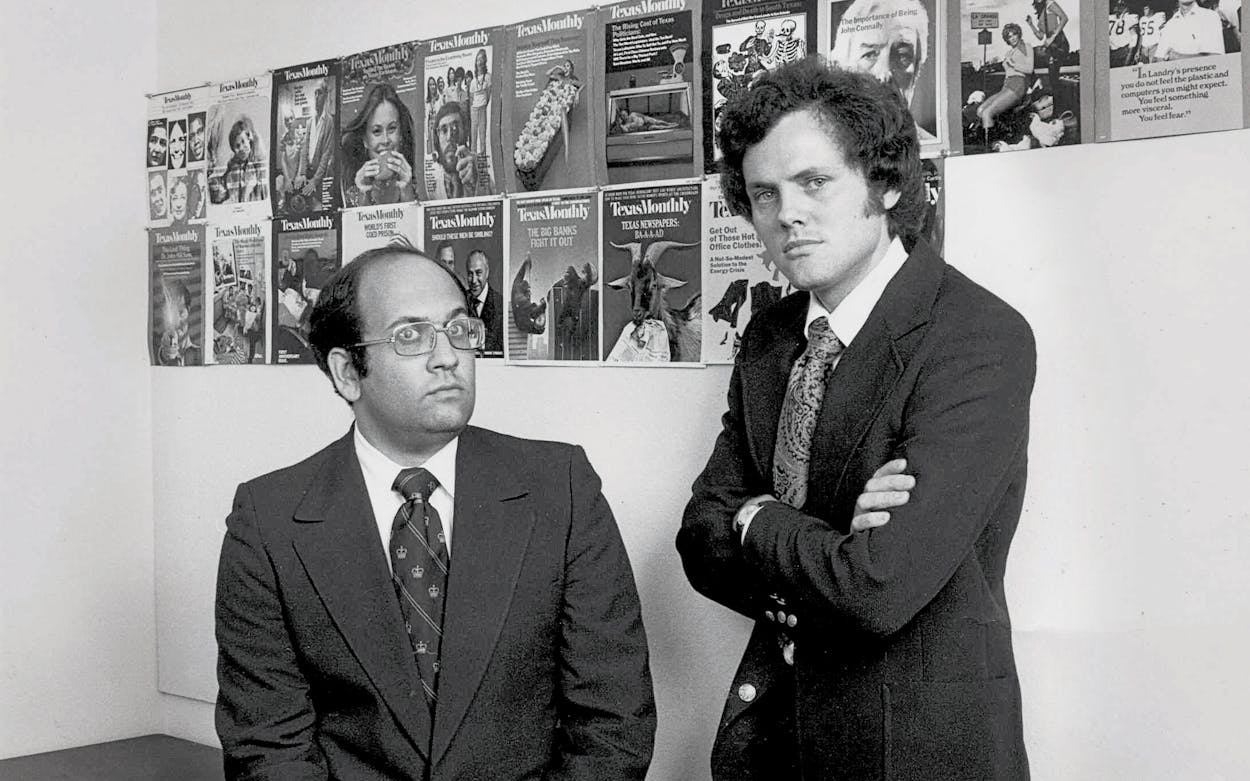Fifty years is a long time in the life of anyone or anything. Only 6 percent of marriages last that long. Many famous figures, from Jesus to Jimi Hendrix, didn’t reach the half-century mark, nor did once famous firms Blockbuster and Compaq. So it’s with pride, along with gratitude to our readers and advertisers, that Texas Monthly has published a special golden-anniversary issue, our 601st.
When my colleagues and I started planning for this occasion, we wanted to focus less on ourselves than on the fascinating state that we’ve been blessed to chronicle. Executive editor Mimi Swartz, a beloved, 33-year veteran of Texas Monthly, suggested we examine how various Texas icons have changed and endured since the magazine’s birth. We all liked that idea, and deputy editor Jeff Salamon, a deft and patient shepherd of big projects, set about assigning nearly sixty stories about characters, places, and institutions ranging from the Alamo and Southwest Airlines to Beyoncé Knowles-Carter and Flaco Jiménez and the ageless Willie Nelson.
Among those icons, you’ll find Texas Monthly itself. That’s fitting, because ours is a very Texan story. It’s the tale of a visionary young Dallas entrepreneur with an audacious idea, who ignored the naysayers, borrowed start-up funding from his working-class immigrant parents, enlisted other talented young Texans, launched his enterprise, persevered through setbacks, refused to compromise his standards, and built something of lasting value.
That entrepreneur was Michael R. Levy, then age 26, the son of a plumber who had immigrated from Poland. Mike was the first in his family to attend college, the prestigious Wharton School at the University of Pennsylvania. While still a student, Mike freelanced as a journalist, and after graduation he sold ads for Philadelphia magazine. He went on to earn a degree from the University of Texas School of Law. But he kept thinking about his time in Philly. If that city—and others, including Chicago, Los Angeles, and New York—hosted magazines that covered the concerns and passions of each place, why not launch a similar magazine for and about all of Texas?
As Mike began to discuss the idea with veteran editors, many dismissively waved him away. The conventional wisdom in publishing held that city magazines flourished because readers were closely connected to the community where they worked and played. Few felt the same way about their state. But Mike knew Texas was different. It had stood as an independent republic for nearly a decade before it joined the United States. Texans lived longer in their home state than did other Americans. They were also more likely to attend a university within the state, and, I’ve observed, to meet a future spouse there, to make friends from far-flung corners of Texas—and to spend the rest of their lives happily driving for hours to visit those folks on weekends and holidays. Texans took a strong interest not only in their hometowns but in goings-on all across the Lone Star State, including its blood-sport politics and bizarre crimes, inventive barbecue and taco joints, favorite swimming holes and honky-tonks, risk-defying wildcatters and other larger-than-life characters. Mike told me he came to believe that “God wanted there to be a magazine called Texas Monthly.” It turns out that Texans wanted that, too.
After interviewing scores of candidates, Mike chose as his founding editor William Broyles, then 27, a Houston native just returning from combat as a Marine lieutenant in Vietnam. Bill had little experience in journalism, but he knew and loved Texas and shared Mike’s vision for a magazine about it. He’s written a fine piece about the heady days leading up to Texas Monthly’s first issue, February 1973, and the publication’s early years. Like many of our alumni, Bill went on to achieve fame in other realms, including as a screenwriter for two movies starring Tom Hanks: Castaway and the Oscar-nominated Apollo 13. “The key to Texas Monthly’s success,” Bill told me, “was that Mike and I and our team weren’t part of the Texas publishing establishment, so we didn’t know that we couldn’t do what we went out and did.”
What they did was remarkable not only journalistically—Texas Monthly has won a total of fourteen National Magazine Awards, the Oscars of our industry—but also commercially. Though they began in the teeth of the 1973–1975 recession, Mike and his business team steadily increased the magazine’s ad sales and circulation, as it grew to reach more than two million Texans each month. Mike allowed his editors to operate without influence from advertisers. But he did insist that the magazine maintain a core group of staff writers (instead of depending entirely on freelancers, as many magazines did) and that it hire a team of rigorous fact-checkers and copy editors—a rarity then and even more so today. Mike sold the magazine in 1998 and left its employ in 2008, but he remains on our masthead as founder and publisher emeritus, and his entrepreneurial spirit lives on.
We’ve also published a story about the evolution of Texas Monthly, penned by Stephen Harrigan, who began writing for the magazine shortly after its founding. He continues to do so today as one of our most popular contributors but is perhaps best known as author of the authoritative history of Texas, Big Wonderful Thing, and of several acclaimed novels, including The Gates of the Alamo and, most recently, The Leopard Is Loose.
The competitive landscape for journalistic organizations has been radically transformed in recent years, with many laying off employees or closing their doors entirely. Texas Monthly experienced similar woes, especially between the Great Recession’s start, in 2007, and the end of 2018. During that time, more and more Americans who love great nonfiction storytelling sought it not only in printed magazines and books but also on websites and in videos, podcasts, live events, and email newsletters. In response, we’ve expanded to serve our audience on each of those platforms and have optioned the rights to develop several dozen stories as Hollywood movies and streaming series. Texas Monthly is now on the short list of U.S. publications that is growing in audience and revenue, with an editorial staff that has nearly doubled since 2019.

During those past three and a half years, we’ve been fortunate to have as our owner Randa Duncan Williams, who has provided us the patient capital required to grow and diversify our offerings. Thanks to Randa’s investments and the hard work and creativity of our editorial and business staffers, we’re on track to return to profitability within a few years and to sustain quality storytelling about Texas for years to come.
A graduate of the University of Houston Law Center, Randa serves as chairman of Enterprise Products Holdings, the general partner of the midstream energy company founded by her father. She is an avid reader of authors ranging from Jane Austen to Rick Riordan. She has been a fan of Texas Monthly since she was twelve. She can recite passages from her favorite articles, some of which we published more than a decade ago. And, like Mike, she has been a fierce defender of our editorial independence. “Along with millions of other Texans, I’m thankful that Mike Levy persisted with his crazy idea to create Texas Monthly,” Randa told me. Every business that lasts fifty years has had to navigate one challenge after another, she noted, adding: “Our team is committed to adapting, while also continuing the legacy of great storytelling that we’ve inherited from Mike and Bill and all the other exceptional journalists and business staffers who came before us.”
This article originally appeared in the February 2023 issue of Texas Monthly with the headline “A Very Texan Story.” Subscribe today.









